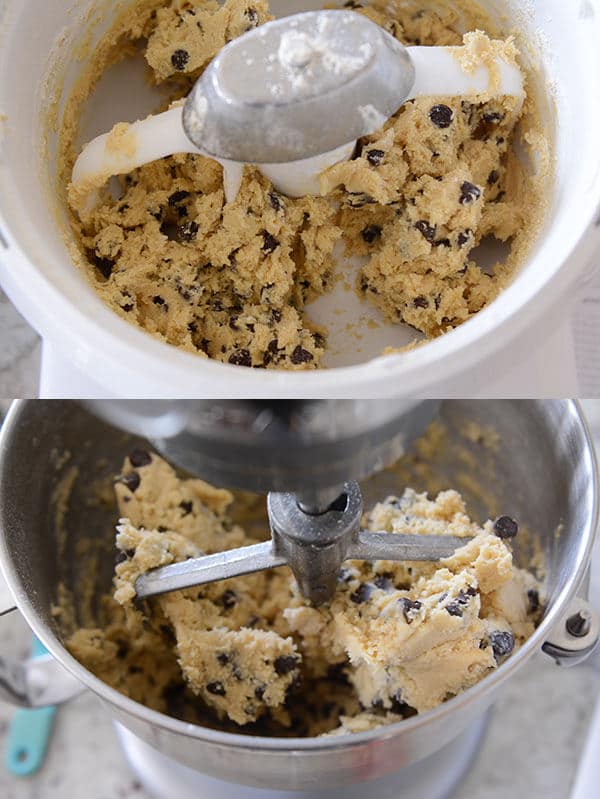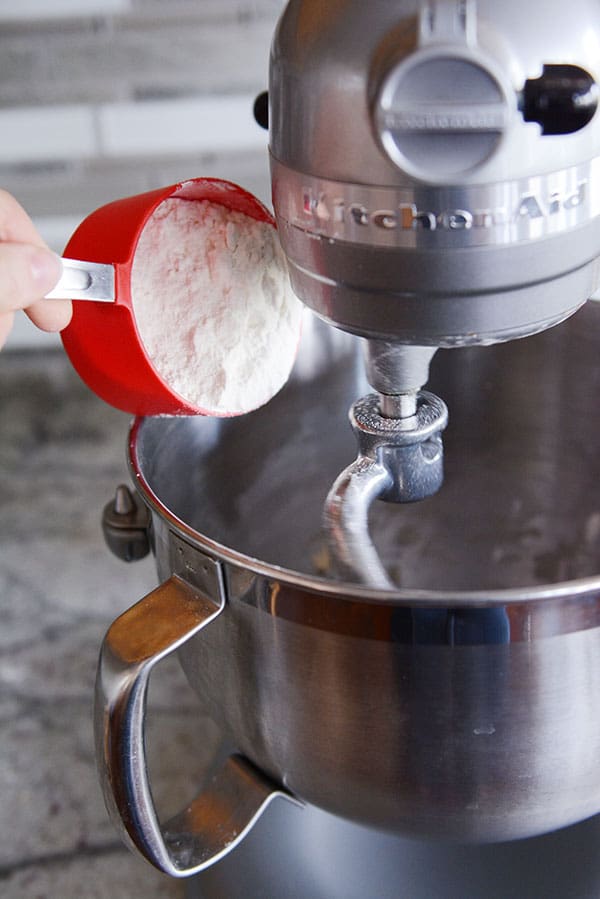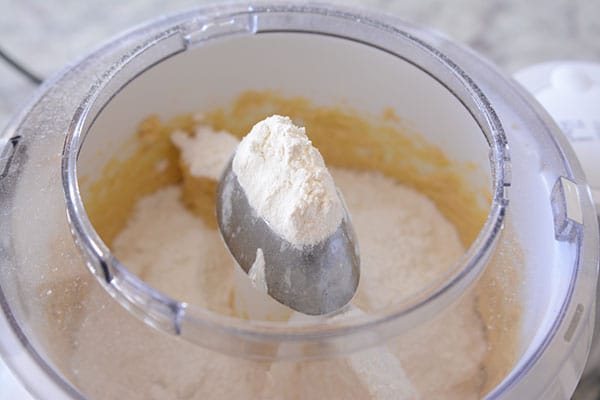KitchenAid vs. Bosch {Which Mixer Do You Really Need?}
It’s KitchenAid vs. Bosch! In this ultimate showdown between two of the most popular stand mixers on the market, learn the ins and outs of each mixer, and find out which stand mixer is right for you!
Disclaimer: this is an unsponsored post (i.e. I haven’t been paid to talk about these mixers); this post contains a few affiliate links which means that, at no additional cost to you, I may earn a small commission if you make a purchase. Thanks so much for your support in this way!. As always, feel free to shop around for the best price!

In my extremely scientific (read: not scientific at all) research analysis, I’ve found that out of all my readers that own a stand mixer, most of you have either a KitchenAid or a Bosch mixer.
There are other brands on the market, but today, I want to focus on these two mixers.
It’s a battle of KitchenAid vs. Bosch!

My Experience Using Both Mixers
They are vastly different mixers. You can see this immediately in terms of shape, color, size, and design.
And because of that, each have good points…and some not so good points.
I’ve been a loyal Bosch Universal fan for years. I received one in the first years of my marriage and have been using it since (not the original mixer – I gave that one to a friend when I upgraded to the new model design a couple of years ago, but the 14-year old Bosch is going strong for my pal, Katie).
As for using a KitchenAid, many years ago, Costco was running a huge rebate on KitchenAid mixers, and I took the plunge and snagged one during the sale.
I never thought I would be a KitchenAid owner (or fan), but after hearing several friends rave about their KitchenAid’s strengths, I decided I wanted to try one out for myself.
She’s definitely a beauty, no doubt about that.
In all honesty, I was tempted to return the KitchenAid mixer within the first few weeks I had it (mostly because it felt, and still feels sometimes, excessive to have two stand mixers), but I stuck out the learning curve of a new mixer, and I’m glad I did, because it’s given me time to figure out which mixer really is the best.

Comparing KitchenAid to Bosch Universal
The KitchenAid I bought at Costco is unique to Costco stores and is a bit different than KitchenAid mixers you can buy online or at other stores, but it is very similar to this KitchenAid mixer.
This is the Bosch Universal mixer I have.
The Bosch stand mixer is also offered in a compact version (400 watts, 4-quart bowl capacity, about $189). And the KitchenAid mixers come in many different variations of motor power and bowl capacity (such as this 5-quart, 325 watt mixer, about $299).
For the purpose of today’s KitchenAid vs. Bosch post, I want to compare similar models between brands (so that it wouldn’t be an unfair contest, like comparing a Ferrari to a Nissan Sentra).
Below, you can see some of the basic specs for each of the mixers.

Fairly similar in price and bowl capacity, the Bosch shines in it’s higher powered motor at 800 watts (and let’s be serious, the KitchenAid can’t be beat when it comes to color options).
This makes a big difference when it comes to making things like bread. If I had a dollar for every time I heard that someone’s KitchenAid mixer burned up making bread…
It seems to be a common issue with KitchenAid mixers, although less so with higher powered KitchenAid’s (500 watts and above).
However, I have never heard anyone say their Bosch mixer motor burned out, especially not while making bread, which brings me to my first comparison point.
The Bosch Shines at Bread-Making
The Bosch Universal is hands down the best mixer for making bread.

Because of the bowl design (the mixing shaft comes up from the bottom rather than the top, like the KitchenAid), and because of the higher power, the Bosch can easily hold upwards of 22 cups of ingredients in the bowl and will mix bread like a boss.
I always make large batches of bread in my Bosch, including my go-to whole wheat bread recipe that makes 5-6 loaves.

I think the Bosch handles small batches of dough just fine, also, although I will say that this is a common complaint with the Bosch: small batches of anything don’t fare well.
The secret I’ve learned is to add the flour very gradually for small batches of bread in the Bosch, otherwise, you’re left with dry patches as the dough just spins aimlessly in the mixer unable to incorporate all the ingredients.
The KitchenAid and Bread-Making
Now let’s talk about the KitchenAid and bread.
I have turned to my KitchenAid a time or two to make smaller batches of bread (like these divine breadsticks).
It works fine, but I find it’s much easier to overflour the dough in the KitchenAid in order to get all the ingredients mixed based on how the dough hook moves around the bowl.
Making large batches of bread dough is out when it comes to the KitchenAid, in my opinion, but small batches seem to work ok. I’ve found I often have to scrape the sides of the bowl down to help incorporate flour – a difference between KitchenAid and Bosch as I never have to scrape down the sides of the Bosch bowl when making bread.

I’m going to detail a few more side-by-side comparisons below, but if you want to jump right to an overview, here’s a little chart for an at-a-glance picture at how these mixers measure up against each other.

Cookie Making in a KitchenAid and Bosch Universal
Both the Bosch and the KitchenAid are awesome for cookie making.
I made the exact same chocolate chip cookie recipe side-by-side in each mixer.
You can see that initially, the Bosch does a slightly better job at incorporating the butter and sugar together. The butter doesn’t get as hung up on the cookie paddles in the Bosch like it does in the KitchenAid.
As a sidenote, the cookie paddles are not included with the Bosch mixer, but are totally worth the extra $20 purchase; I use the dough hook or cookie paddles for everything I make in the Bosch.
UPDATE: I’ve started using the cookie paddles to cream the soft ingredients and then switch to the dough hook when adding the dry ingredients (I had a couple sets of cookie paddles break on me). And often, I just use the dough hook start to finish.
This dough hook that is sold separately is a game changer for the Bosch – it helps with dough climbing up the center column and overall just does a better job mixing any and all ingredients. I wish this was the dough hook shipped with the Bosch!

After a little pause for scraping the butter off the paddle, the KitchenAid works great.
Interestingly both mixers struggled a bit to incorporate the eggs into the cookie dough without some excessive scraping action, as well.
Which brings me to a pretty major point that BOTH mixers have issues with ingredients getting stuck to the bottom of the bowl, especially with wet batters or doughs, and based on design (and even after manipulating the screw on the KitchenAid to bring the paddle closer to the bottom of the bowl), it requires some scraping to get everything incorporated.

This is NOT an issue when doubling a standard cookie dough recipe in the Bosch, FYI (beautiful double batch of cookie dough pictured just below).
The larger quantities of everything seem to help the paddles pick up all necessary bits, but doing the same and doubling a cookie dough recipe in the KitchenAid, I still had to dig in there to scrape lingering bits of butter and sugar off the bottom (but not necessarily the sides).

After the egg/vanilla point in cookie making, both mixers handle the cookie dough like the professionals they are.

Since I already touched on it above, let’s talk about the issues of making smaller batches of recipes in each mixer.
Small Batches/Thinner Batters
No offense to my Bosch, but it stinks when making small batches of anything. Even though the description will say it can whip even one egg white to stiff peaks (and it may, I’ve never tried it), when it comes to small, or more particularly, thinner/wetter recipes, I have to do a lot of scraping, especially on the bottom of the bowl, to help incorporate the ingredients.
There IS a bowl scraper available, but I don’t have it and can’t attest to whether it helps this issue out or not, and it certainly wouldn’t help with all the goodness that gets stuck on the center shaft of the mixer and the bottom of the bowl.
The solution in the Bosch is usually to double the recipe (not always possible, I know). A batch of frosting that might need a lot of scraping usually does great when doubled.

Even though the KitchenAid does require some initial scraping to get ingredients off the bottom of the bowl, it really shines when mixing wet batters, like cake recipes or frosting, or for whipping cream or egg whites.
There is also a scraper attachment for KitchenAid mixers. Again, I don’t have this, but it may be a help, although my issue with the KitchenAid is the ingredients that hang out on the bottom of the bowl even after adjusting the height of the mixer.
Despite having to still pull up ingredients from the bottom of the bowl, the KitchenAid is hands down the best mixer for standard-size recipes of thinner/wetter ingredients.

And I love having it for this perfect yellow cake recipe (although keep in mind when I made that dang recipe 17 times to get it perfect, I didn’t have a stand mixer, so my handheld mixer – more details below – did the job).

Ease of Use
I’m not going to lie, I’ve wanted to kind of scream in my pillow sometimes at trying to add ingredients to the KitchenAid while it is mixing.
My measuring cups hit the side of the mixer when adding flour and other dry ingredients; it’s hard to get all the flour added without banging the measuring cup against the side of the bowl like a madwoman to expel the last specks of flour.
If you have the flexibility to stop the mixer and lower the bowl, it’s much easier, but in small batch bread dough recipes or any recipe where you need to add ingredients gradually, it’s a pain.

However, adding liquid/wet ingredients, like eggs or milk, seems to be much easier.
I don’t know if it’s the measuring cups I’m using or not, but clearly, adding ingredients to the KitchenAid is kind of a love/hate thing for me.

The Bosch, on the other hand, is easier for adding ingredients while the mixer is running thanks to the open top design.

However, after adding dry ingredients, some light sweeping is usually necessary to get the excess flour (or whatever) off the metal driver.
And take care to avoid the plumes of whispy flour (or powdered sugar) that puff out of the mixer and may cause minor coughing fits (which is mainly caused by one sticking their face too close to the mixer during the dry ingredient adding procedure – not that I would ever do that).
Cookie maker beware.

Where Does This Leave Us?
You can probably already see (if you made it this far, and if so, you deserve a cookie), that instead of proclaiming a true winner, it’s clear that each mixer has it’s strengths and weaknesses.
And much of the decision about which mixer to buy really depends on what you predominantly plan to make with it.
For serious bread makers and avid bakers of many types, the Bosch is a strong contender.
For those that see themselves making average-sized batches of cookies and cakes more than bread, the KitchenAid might be the best option.
And just to muddy the waters a bit, I have to say that in addition to my two stand mixers, I rely heavily on my everyday hand mixer, too.

For the longest time (over a decade), it was just me, my Bosch, and my trusty hand mixer that I used to make smaller batches of frosting, thin cake batters, etc.
Maybe it’s just because I’m a creature of habit, but I like having it around.
And since I’m clearly having a good time putting together charts, here’s a recap of which mixer I use..and for what.

It’s probably really obvious from this post that I’m a huge fan of the almighty Bosch. I can’t help it. She’s been by my side for over a decade.
If I had to choose between mixers, I’d definitely go with a Bosch Universal.
For me, a Bosch + hand mixer (for those thinner batters) is everything I would need for day-to-day cooking and baking operations in my kitchen.
However, the lovely KitchenAid cannot be discounted in terms of all-purpose use, especially if there isn’t going to be much bread or large-batch baking.

And, I will definitely say that if you are into looks, the KitchenAid has much more of an ooh-la-la factor. They are shiny and purty, no doubt about that.
The Bosch, on the other hand, isn’t fancy and doesn’t come in a million colors – it is definitely more on the humble, hard-working side of things.
And guess what? I also believe you can live your life fully and with lots of joy without even owning a stand mixer!
So, now it’s YOUR turn! If you are a stand mixer owner, which one do you have? And why do you love it?
Thanks for sticking with me for this detailed post (assuming you did, ha!). Feel free to ask any additional follow-up questions or clarification in the comments. Later, skaters!

I just made cookies in my new Bosch for the first time. I didn’t buy the cookie paddle because I saw your comment above about often just using the dough hook for cookies. This didn’t work well for me. It struggled to cream the butter and incorporate sugar and eggs (made your white chocolate chippers – which I’ve made dozens of times and they’ve always been perfect until tonight). They turned out drier than normal. Any thoughts? Cookie paddle worth it?
Hi Madison – if the dough hook isn’t working well start-to-finish for cookies, the cookie paddles may be worth it to use for creaming the wet ingredients together. Then, I’d recommend switching to the dough hook once the flour is added.